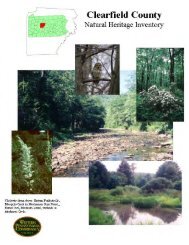Cranefly orchid - Pennsylvania Natural Heritage Program
Cranefly orchid - Pennsylvania Natural Heritage Program
Cranefly orchid - Pennsylvania Natural Heritage Program
Create successful ePaper yourself
Turn your PDF publications into a flip-book with our unique Google optimized e-Paper software.
Species: <strong>Cranefly</strong> <strong>orchid</strong> (Tipularia discolor)Global Rank: G4G5State Rank: S3Climate Change Vulnerability Index: Moderately VulnerableConfidence: Very HighHabitat:The range of the cranefly <strong>orchid</strong> extends south from New York to Florida and Texas andwest from the east coast to Illinois, Missouri and Oklahoma (NatureServe 2010). Itoccurs at the northern tier of its range in <strong>Pennsylvania</strong>/New York but is restricted tocalcareous mesic forests in the southern third of <strong>Pennsylvania</strong>.Threats:The cranefly <strong>orchid</strong> is threatened by deforestation, displacement by exotic plant species,changes in soil chemistry, loss of associated soil mycorrhizae, and deer herbivory(Whigham 1990, 2004).Main Factors Contributing to Vulnerability Rank:Predicted impact of land use changes designed to mitigate against climate change:The rich soils where the species occurs may be attractive for plantation development forbio-diesel farms.Dispersal ability: <strong>Cranefly</strong> <strong>orchid</strong>s produce wind dispersed dust seeds (Rasmussen andWhigham 1993) and are capable of clonal reproduction. However, both are shortdistance dispersal mechanisms.Predicted macro sensitivity to changes in precipitation, hydrology, or moisture regime:Considering the range of the mean annual precipitation across the species’ range in<strong>Pennsylvania</strong>, the species has experienced a small precipitation variation in the past 50years.Forms of mutualism: A mycorrhizal association is required for seed germination andadditional mycorrhizal associations may be required during other life stages of the plant(Rasmussen and Whigham 1998).Literature Cited:NatureServe. 2010. NatureServe Central Databases. Arlington, Virginia. USA.Rasmussen, H.N. and D.F. Whigham. 1993. Seed ecology of dust seeds in situ: a newstudy technique and its application in terrestrial <strong>orchid</strong>s. American Journal of Botany 80:1374-1378.
Rasmussen, H.N. and D.F. Whigham. 1998. Importance of woody debris in seedgermination of Tipularia discolor (Orchidaceae). American Journal of Botany 85:829-834.Whigham, D.F. 1990. The effect of experimental defoliation on the growth andreproduction of a woodland <strong>orchid</strong>, Tipularia discolor. Canadian Journal of Botany 68:1812-1816.Whigham, D.F. 2004. Ecology of woodland herbs in temperate deciduous forests.Annual Review of Ecology, Evolution, and Systematics 35: 583-561.










